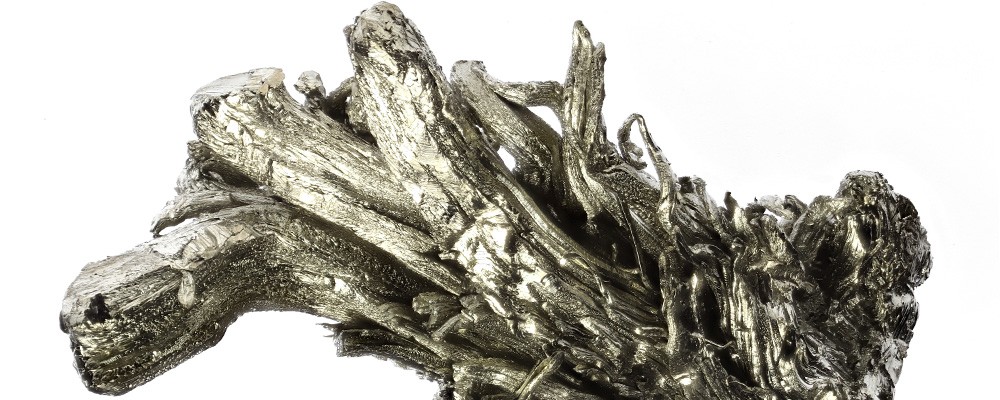Filter
Looking for something?
If you do not see anything that suits your needs, please get in touch with your requirements.
Custom EnquirySc2O3 3-12mm Pieces (sintered) 99.99% Pure
Scandium Oxide
Sc 1-6mm Pieces Sc/TREM 99.99% TREM 99.5%
Scandium
4.1 UN3089 PG II Flammable
Sc 3-10mm Pieces Sc/TREM >99.99% Packaged under Argon
Scandium
4.1 UN3089 PG II Flammable
Sc 3-6mm Pieces Sc/TREM >99.99% TREM 99.5%
Scandium
4.1 UN3089 PG II Flammable
Sc Pieces <10mm TREM 99.5% Sc/TREM 99.99% Packaged under Argon
Scandium
4.1 UN3089, PG IIFLAMMABLE
ScCl3 -20 mesh 99.9% Pure
Scandium Chloride
ScF3 -200 mesh (precipitated) 99.9% Pure
Scandium Fluoride
ScI3 -20 mesh 99.9% Pure
Scandium Iodide
ScN -60 mesh 99.9% Pure
Scandium Nitride
ScO3 -325 mesh (typ. =5 microns) 99.99% Pure
Scandium Oxide
ScO3 -325 mesh (typ. =5 microns) 99.95% Pure
Scandium Oxide
Sc2S3 -200 mesh 99.9% Pure
Scandium Sulphide
Sc2Te3 -20 mesh 99.9% Pure
Scandium Telluride
Sc Rod 6.35mm dia x 200mm long Sc/TREM 99.99% Pure
Scandium
Sc Rod 3.2mm (+/-0.15) dia x 50mm (+/-1.0) long 99.99% Pure Temper Hard
Scandium
Sc Rod 5mm dia. x 10 to 50mm long 99.95% Pure
Scandium
Sc Rod 3.2mm (+/-0.15) dia. x 100mm (+/-1.0) long 99.99% Pure Temper Hard
Scandium
Sc Rod 25.4mm dia x 50.8mm long Sc/TREM 99.99% Pure
Scandium
Sc 5mm dia. x 5mm length 99.9% Pure
Scandium
Sc Rod 6mm dia. x 175mm long 99.9% Pure
Scandium
Sc Rod 6mm dia. x 200mm long TREM 99.9% Sc/TREM 99.99%
Scandium
Sc Rod 8mm dia. x 175mm long 99.9% Pure
Scandium
Sc sheet Thickness 0.50mm (0.020") Purity 99.9%
Scandium
Sc sheet Thickness 0.76mm (0.030") Purity 99.9%
Scandium
Sc sheet Thickness 1.0mm (0.040") Purity 99.9%
Scandium
Scandium Sc, TREM99.5%, Sc/TREM 99.99%
Scandium Sc, TREM 99.9%, Sc/TREM 99.99%
Scandium Sc, TREM 99.99%, Sc/TREM 99.99%
distillation method
Scandium Oxide Sc2O3,
Purity 99.99%
Sc2O3 TRG 25.4mm dia. x 6.35mmTk 99.99% Pure
Scandium Oxide
Sc2O3 TRG 50.8mm dia. x 3.18mm Tk 99.99% Pure
Scandium oxide
Scandium-Aluminium Sc-Al,
Available in various ratios wt% or at%, Purity 99.9%
Scandium oxide-Lutetium oxide Sc2O3-Lu2O3,
Purity 99.99%
Scandium, a rare and intriguing metallic element, possesses a unique set of characteristics that distinguish it within the periodic table. Its hardness, silvery appearance, and notably dark metallic hue mark it as an element of interest. When exposed to air, scandium develops a subtle yet distinctive yellowish or pinkish tint, adding to its allure.
Despite its remarkable properties, scandium is not impervious to the elements. In its pure form, it succumbs to weathering over time and is prone to degradation upon prolonged contact with most dilute acids. However, it exhibits a notable resistance to a specific combination of nitric acid (HNO3) and hydrofluoric acid (HF), a trait shared with certain other reactive metals.
The rarity of scandium is not merely incidental but rather rooted in the intricate processes of nuclear fusion. Thermonuclear reactions responsible for generating elements in the range of scandium's atomic number tend to favour those with an even atomic number. Consequently, elements such as argon (atomic number 18), calcium (atomic number 20), titanium (atomic number 22), and chromium (atomic number 24) are more abundant. In contrast, elements with odd atomic numbers, including potassium (atomic number 19), scandium (atomic number 21), and vanadium (atomic number 23), are produced less frequently and thus remain comparatively scarce.
The production of odd-numbered elements within this range arises from less common thermonuclear reactions, a phenomenon elucidated in scientific discourse. This intricate interplay of nuclear processes contributes to the rarity and distinctiveness of scandium, underscoring its significance in the realm of chemistry and physics. Understanding the origins and properties of scandium offers valuable insights into the broader complexities of elemental synthesis and the natural world's intricate workings.
